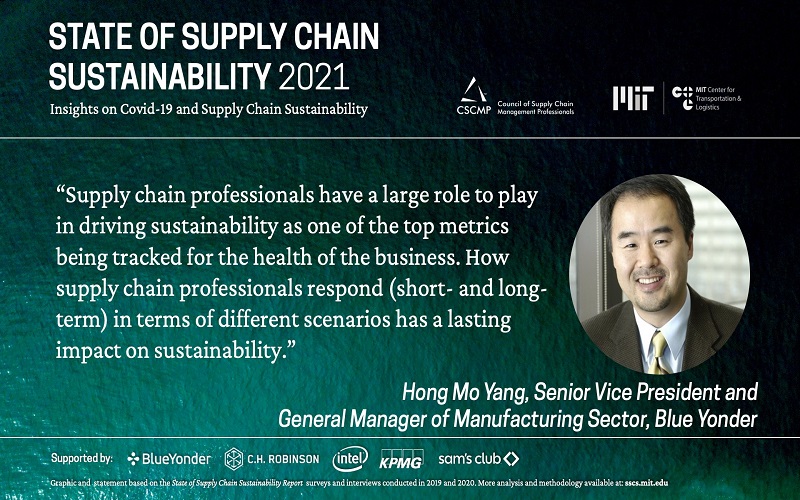How Luminate Control Tower is helping our customers, and getting recognized by Microsoft’s Satya Nadella in global conference keynote
Do you hear that?
It’s the collective sigh from many of us who have been fervently working toward building the future of sustainable supply chains. Why the sigh, you ask? It’s because we’ve been panicked over the past 18 months that our progress may have taken a back seat during the COVID-19 outbreak when manufacturers, distributers and retailers were so focused on simply getting the basics — like toilet paper — to consumers. But according to the hot-off-the-presses State of Supply Chain Sustainability Report conducted by MIT Center for Transportation & Logistics and the Council of Supply Chain Management Professionals, not even a global pandemic could slow down interest in supply chain sustainability (SCS). “More than 80% of survey respondents in this year’s report claimed the crisis had no impact or increased their firm’s commitments to SCS.”
So now that we’ve boarded the train to SCS, where do we go from here? We think it’s important to first understand our past so that we know where we’re headed next. Yesterday’s linear supply chain was driven by cost, service and profits. This led to many negative implications, such as shortened life cycles, processes and materials that flow in one direction, suboptimal utilization of materials and energy, and limited visibility to identify and resolve environmental impacts.
But success today looks very different, as it’s focused on ethical, environmental and social responsibility. Doing what’s right for people and the planet is no longer optional — it’s a requirement. Here at Blue Yonder, we believe the building blocks to SCS are what we call The 4 Cs of the Sustainable Supply Chain:
- Circular: Utilizes intelligent decision making to operate responsibly
- Challenge ready: Anticipates, understands, and adapts to external factors
- Collaborative: Consciously collaborates to achieve sustainability goals
- Connected: Has multi-echelon supply chain visibility
As a leader in supply chain solutions, we know we play a critical role in SCS, and we are on a mission to help each of our customers weave The 4 Cs into their everyday operations, from raw materials to manufacturing to the consumer’s hands. Sustainability cannot be a separate box to check — it must be ingrained in every system and every decision.
We’re proud of the work we’ve done thus far in our journey to sustainability, but we know we have more work to do too. We’d love to share what we’re building for our customers to help them reduce waste, reduce their carbon footprint, and make supply chain sustainability top of mind every day.
These are three upcoming enhancements to Luminate™ Control Tower, our award-winning software-as-a-solution (SaaS) that provides real-time visibility, orchestration, collaboration, and prescriptive resolutions across the entire supply chain:
Carbon Footprint
The Carbon Footprint dashboard looks at all the shipments from customers across different modes and provides a carbon emissions report that can benchmark how well you’re performing year-over-year, identify outliers, and produce key insights for you to act on.
Waste Reduction
The Waste Reduction dashboard does exactly what its name implies — it helps our customers reduce waste by recycling and repurposing expiring inventory, identifying and optimizing container fill rates, and determining warehouse capacity and allocating inventory.
Sourcing Lanes
The Sourcing Lanes dashboard helps planners identify and choose the most optimal routes for shipments based on carbon emissions, with decisioning that’s as easy to read as a traffic light.
We’re excited for our customers to use these upcoming Luminate Control Tower dashboards to help with their own sustainability journeys, and we’re eager to continue developing more ways to help them embrace the sustainable supply chain.
In fact, Luminate Control Tower was recently highlighted by Microsoft’s CEO Satya Nadella in his keynote at Microsoft Inspire, a global conference, for the work the team did during the Suez Canal situation in March. The solution helped our customers track vessels along the route to gain visibility into potential disruptions by predicting the time of arrival at the port of discharge through final delivery. In real time, the solution predicted the impact on our customer’s inventory, production capacity and sales. We succeeded in the goal of helping our customers take corrective actions to mitigate the impact of this disruption. Watch the keynote:
We might be breathing a sigh of relief that companies are still moving forward with their SCS plans — even amid a global pandemic! — but we’re not stopping the momentum of this sustainability train anytime soon.
To read the full State of Supply Chain Sustainability Report, click here.
To learn more about Luminate Control Tower, click here.

